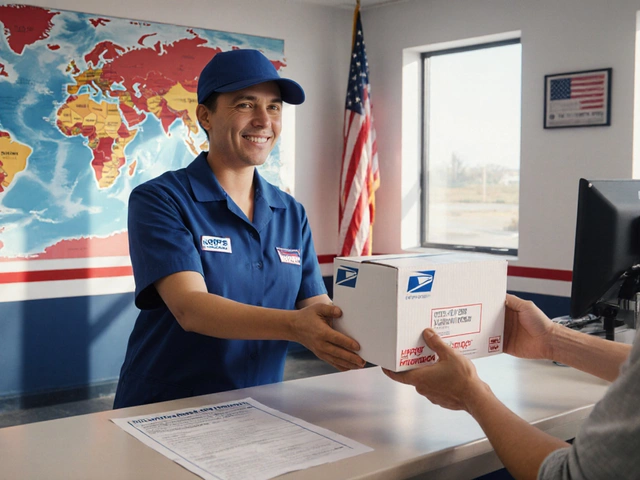Trying to figure out how much it’ll cost to courier your stuff can feel like staring at a puzzle you lost half the pieces to. Prices seem to jump all over the place, and every courier company has its own system. Toss in bulky items, weird destinations, or last-minute deadlines, and suddenly that simple parcel can end up costing more than you expected.
So what’s the deal? Courier prices depend on a handful of key things: package size and weight, where it’s going, how fast you want it there, and which company you pick. But that’s not all—sometimes sneaky little fees show up on your bill too. It’s super easy to overpay if you’re not watching for the fine print.
Let’s dig into what makes up those costs, why rates can be wildly different between a local drop-off and an international shipment, and how you can sidestep the usual money traps. By the end, you’ll know exactly what to expect and how to get the best bang for your buck.
- What Actually Affects Courier Pricing?
- Typical Costs for Different Types of Deliveries
- Hidden Fees Couriers Don’t Advertise
- Tips to Cut Down Your Courier Expenses
What Actually Affects Courier Pricing?
If you’ve ever compared two shipping quotes and wondered why one costs three times as much, you’re not alone. There are a few real reasons behind those sometimes wild differences in courier cost.
- Package Weight and Size: Couriers love to price based on how big and heavy your item is. A small package can cost a fraction of what a bulky box does, even if they’re both going to the same address. Some companies use “dimensional weight,” which means they charge you for the space your item takes up, not just the actual weight.
- Destination: Local delivery within the same city is always much cheaper than shipping to another country. Crossing borders adds entry fees, customs duties, and sometimes taxes.
- Speed of Delivery: Need it tomorrow? Like, really need it? Get ready to pay a premium. Standard shipping is the cheapest, but overnight or same-day parcels rack up the bill fast.
- Type of Item: Fragile, valuable, or hazardous content can mean extra charges. Lithium batteries, glass items, or electronics may require special handling or insurance.
- Service Level: Economy, standard, express, same-day—each service comes with its own price tag based on how fast and traceable your package needs to be.
Just to put numbers in perspective, here’s how rates usually look for the same 2kg box sent from New York to London, using three different options:
| Service Level | Average Price (USD) | Delivery Time |
|---|---|---|
| Economy | $60 | 5–7 days |
| Standard | $95 | 3–5 days |
| Express | $140 | 1–2 days |
These are ballpark figures, but they show how different shipping speeds and service choices can change your total bill.
If you’re sending to a rural spot, expect a “remote area surcharge,” which is a real thing with most big players. And if your item is oddly shaped or oversized, the price goes even higher. Bottom line: it’s smart to check all these factors before sealing up your box and booking a courier.
Typical Costs for Different Types of Deliveries
Alright, let’s get to the numbers. You’re probably wondering what real people actually pay to send something with a courier. Rates change all the time, but you can usually get a ballpark figure based on where it’s going, how heavy it is, and how fast you need it to arrive.
For a super basic local delivery—think sending a document or a small box across town with a major service like FedEx, UPS, or DHL—you’re often looking at $10 to $25. These are same-day or next-day options, and the range shifts if your city is huge or if traffic’s always a nightmare. Toss in a bigger box, and the price can climb to $30 or more for the speedy services.
National deliveries (within the same country) jump up depending on distance and speed. Shipping a small package across states in the U.S., for instance, usually lands between $15 and $40 if you’re not in a rush. Express or overnight? Double it. Something heavy—like 25 pounds or more—can quickly run $60 to $100, especially if you want that package quick.
International shipping is a whole different beast. Send a 2kg box from New York to London, and standard service (with tracking) can easily hit $55–$80. Express delivery is often $100 or more, even for lighter items. The size of your package and the customs forms needed also push up the total.
To put these courier cost numbers in perspective, check out this quick comparison table:
| Type of Delivery | Example | Estimated Price (USD) | Usual Delivery Time |
|---|---|---|---|
| Local – Same City | Small package, same day | $10 – $30 | Same/Next Day |
| National – Same Country | Standard box, 3-day service | $15 – $40 | 2–4 Days |
| National – Large/Heavy | 25 lb box, 2-day service | $60 – $100 | 1–3 Days |
| International – Standard | 2kg package, NY to London | $55 – $80 | 5–10 Days |
| International – Express | 2kg package, NY to London | $100+ | 2–4 Days |
Extra services add dollars fast. Want proof of delivery, signature, timed pickup, insurance, or fragile item stickers? Those all come with their own price tags. If you’re in a major city, apps like Uber Connect or local courier startups might undercut big brands for local trips, sometimes starting at under $10.
One more thing—the cheapest rate isn’t always the best deal. Some budget couriers skip tracking, give a wide delivery window, or aren’t much for customer support. Always check what’s included in the price. If speed, security, and knowing where your parcel is at all times matter to you, don’t just go with the lowest number you see.

Hidden Fees Couriers Don’t Advertise
Ever looked at your final courier bill and wondered why it’s way higher than the price you first saw? Here’s the thing—courier companies love to sneak in extra charges that most people completely miss. If you don’t know what to watch out for, you could end up paying double what you expected.
The most common surprise fee is the “fuel surcharge.” This one pops up on almost every bill, and the rate isn't even fixed—it goes up or down based on current fuel prices, sometimes changing weekly. For express shipping, the surcharge can be as high as 15% of the base rate. That adds up fast, especially for international deliveries.
Another catch: remote area or "out-of-area" fees. Let’s say you’re sending a box to a rural address or a city far from the courier’s main hubs. Expect an extra $20–$40 tacked onto your bill. Even places you might not think are remote (like certain postcodes on the edge of big cities) can qualify for this fee. Always double-check your destination against the courier’s "remote area" list, which you’ll usually find buried on their website.
Dimensional weight (or “volumetric weight”) charges are another classic. If your package is big but light—think a box of pillows or shoes—you could get billed for taking up lots of space. Most couriers calculate this by multiplying the length x width x height (in cm), dividing by 5000, and charging whichever is higher: the real weight or the volumetric one.
Then there’s the paperwork. Sending something internationally? Couriers often pile on customs clearance fees, duties, or an “administrative charge” for handling forms. Sometimes these are included, but plenty of times, especially with budget services, you get hit with a post-delivery bill. Even within the same country, signature-on-delivery or insurance can add $5–$20 more.
Here are a few extra charges to scan your quote for:
- Address correction fees (if you typo your recipient’s details, expect a $10–$20 fee)
- Saturday or holiday delivery surcharge
- Attempted delivery or “re-delivery” fee if no one’s home
- Parcel pick-up fee (some couriers charge extra if they come to you instead of you dropping it off)
Read the fine print on every courier’s quote. If you’re not sure why a charge is there, ask. The courier cost you see on the site is almost never the total you’ll pay, but at least now you know what’s hiding in the shadows—and you might just avoid the nastiest surprises.
Tips to Cut Down Your Courier Expenses
Not all courier services charge the same, and you don’t have to just accept the first price you see. You can actually lower your delivery fees if you know a few tricks and stay alert for cost traps.
First up, packaging makes a real difference. Most companies price by both size and weight. That half-empty box or messy wrapping? You could pay more than you need to. If you keep items tightly packed and use the smallest sturdy box possible, you’ll likely see a better rate. A study from 2023 showed that shipments in boxes with just 10% excess space were up to 22% more expensive than tight packaging.
- Courier cost calculators are your friend. Don’t guess—plug your parcel details into a few different company websites. Rates can be wildly different for the same item and address.
- Skip express delivery unless you truly need it. Standard shipping can be up to 65% cheaper, especially for domestic packages.
- If you ship stuff regularly, sign up for loyalty programs or business accounts. Some companies offer up to 20% off if you’re a frequent sender.
- Watch for discounts on off-peak days like Wednesdays or Thursdays. Couriers sometimes drop prices to fill empty delivery slots.
- Drop off your parcel at a company facility instead of scheduling a home pickup. It knocks a few bucks off your bill almost every time.
- Double-check addresses and contact details. Failed deliveries cost extra to fix, and some couriers charge a “return to sender” fee that can match or even beat the original shipping fee.
Let’s put the numbers side by side. Here’s a look at average 2024 savings for common tricks:
| Savings Tip | Average Savings (%) |
|---|---|
| Switching to standard from express | 45–65% |
| Tight pack, smaller box | 15–22% |
| Loyalty/business program | 10–20% |
| Off-peak shipping days | 5–12% |
| Facility drop-off (no home pickup) | 3–8% |
These small changes really stack up, especially if you send parcels often. Even for a one-off shipment, taking five minutes to check different couriers or change from express to standard can save you serious cash. Always double-check for extra fees and don’t be shy about asking for a discount, especially if you’re a repeat customer—sometimes just asking works.





